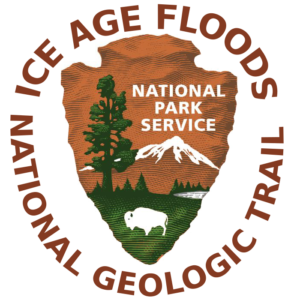Since at least the 1990’s people have been working toward the creation of an Ice Age Floods National Geological Trail. The IAFI has worked from 1995 to the present to build support for this Trail.
In 2001, the National Park Service completed a major Special Resource Study and submitted a report to Congress proposing that an Ice Age Floods National Geologic Trail be established. Such a Trail would represent the largest, most systematic, and most cooperative effort yet proposed to bring the dramatic story of the Ice Age Floods to the public’s attention, and this has the potential to bring significant economic and cultural benefits to communities throughout the Northwest. The Ice Age Floods Study of Alternatives and Environmental Assessment report was prepared by the firm of Jones and Jones and is available in PDF or webpage (HTML) format at this NPS website: http://www.nps.gov/iceagefloods/.
The Ice Age Floods National Geologic Trail is essentially a network of marked touring routes extending across parts of Montana, Idaho, Washington, and Oregon, with several special interpretive centers located across the region.
Route of the Ice Age Floods National Geologic Trail

Proposed Ice Age Floods Pathways (touring routes) and possible locations for interpretive facilities (figure prepared by Jones &Jones)
By bringing together many interested parties, an effective interpretive program can be developed within a collaborative structure and at remarkably low cost, despite the extraordinary size of the region. The Trail can also be developed on existing public lands, with no changes in jurisdiction and no threats to private property rights. The role of the National Park Service would be to coordinate and manage the planning of the project and the telling of the story, not to manage any more land than it already is responsible for.
On March 30, 2009 President Obama signed into law The Omnibus Public Land Management Act of 2009, a bundle of 164 bills, including the Ice Age Floods National Geologic Trail bill. Appropriation of money to staff the trail and create the management plan is the next task.
The National Park Service Management Plan
In the fall of 2005, representatives from NPS and other federal agency partners signed a Memorandum of Understanding to “develop a coordinated and scientifically accepted interpretation of the nationally significant values and features of the Glacial Lake Missoula Ice Age floods”. The agencies have created the Ice Age Floods Interagency Coordination Committee to meet semi-annually to work toward this goal.
The Committee and stakeholders held a workshop in early 2011 at the Washington State Parks Regional Office in East Wenatchee to begin preparation of the foundation statement for the Ice Age Floods National Geologic Trail management plan. A foundation statement is a formal expression of the core mission for a particular national park, or in this case a national trail, and provides basic direction for management decisions about that unit.
A foundation statement provides an opportunity to coordinate all types and levels of planning and decision making from a common understanding. There are four key elements of a foundation statement:
Purpose will provide a defining statement, based on the enabling legislation, of why Congress established the Trail. It will provide the most fundamental criteria against which the appropriateness of all planning recommendations, operational decisions, and management actions will be tested.
Statements of significance will define what is most important about the Trail’s associated resources and values. Guided by legislation and by our more specific knowledge acquired through management, research, and civic engagement, statements of significance will help guide planning and management decisions by focusing attention on those qualities that Congress wanted preserved and interpreted.
Fundamental resources and values are those tangible resources and intangible qualities that are critical to achieving purpose and maintaining significance and warrant primary consideration during planning and management, that, if allowed to deteriorate could jeopardized the integrity of the Trail.
Primary interpretive themes are the key stories, concepts, and ideas for the public to “take away” about the Trail. They will describe what needs to be interpreted in order for people to understand and appreciate the Trail. Interpretive themes are written at many levels, and primary interpretive themes are the most general level. They will not include everything that may be interpreted, but they will help guide the development of the Long Range Interpretive Plan.
Participants at the workshop included representatives from federal and state land management agencies, including: the Bureau of Land Management, Bureau of Reclamation, National Park Service, U.S. Army Corps of Engineers, U.S. Fish and Wildlife Service, U.S. Forest Service, U.S. Geological Survey, and Washington State Parks. Representatives from the nonprofit Ice Age Floods Institute also took part. NPS planners from the Denver Service Center facilitated the workshop. The planning team will continue to refine the foundation elements in the coming months and present a draft for public review and comment during future stages of planning.

